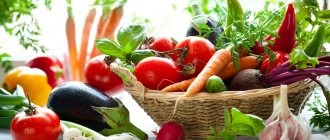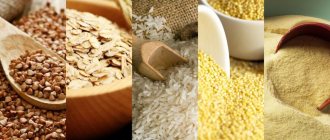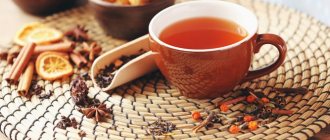Author:
gastroenterologist Anton Smirnov
4 minutes
3947
During breastfeeding, a woman may feel hungry much more often and stronger than usual, and this is normal. The process of making breast milk in the body increases daily energy requirements by about 500 calories. There is also an increased need for specific nutrients such as protein, vitamins D, A, E, C and B12, selenium and zinc.
Here are some healthy and tasty foods that you should include in your diet while breastfeeding, provided that you have no contraindications to them:
- Fish and seafood: salmon, seaweed, shellfish, sardines;
- Meat and poultry: chicken, beef, lamb, pork, liver;
- Fruits and vegetables: berries, tomatoes, sweet peppers, kale, garlic, broccoli;
- Nuts and seeds: almonds, walnuts, chia, flax and hemp seeds;
- Healthy fats: avocado, olive oil, coconut, eggs, full-fat yogurt;
- Fiber-rich starches: potatoes, butternut squash, sweet potatoes, beans, lentils, oats, quinoa, buckwheat. Note that it is recommended to introduce legumes into your diet no earlier than the baby turns three months old in order to avoid problems with excess gas formation;
- Other foods: tofu, dark chocolate, kimchi, sauerkraut.
It is also worth minimizing your consumption of fast food and sugary breakfast cereals, which can be replaced with muesli and granola, for example.
General principles of nutrition during breastfeeding
The nutrition of a nursing woman should be as healthy and healthy as possible throughout the entire period of breastfeeding. Due to errors in eating, the baby may develop colic, bowel dysfunction or allergies. To avoid such problems, a woman who is breastfeeding must follow a certain diet. It is not recommended to eat everything in a row or severely limit yourself in food; you need to find a middle ground.
Compliance with the basic principles will help mommy maintain her health without causing harm to the baby:
- The menu should include many types of foods, including grains, meat, dairy products, vegetables and fruits.
- Complete exclusion of alcohol and tobacco.
- It is necessary to include a vitamin complex in the diet.
- Steam to preserve nutrients.
- Avoid salty, smoked and spicy foods.
Fulfilling such simple conditions will make it possible for the mother to eat simply but efficiently and avoid troubles with the baby’s tummy.
Diet of a nursing mother in the first month
From the second week of a newborn’s life, the mother will be able to understand how and what foods the baby tolerates. Therefore, now the diet can be gradually expanded by adding new foods to the food.
In order for a woman’s body to be able to produce the optimal amount of milk for feeding the baby, the mother needs to drink at least 2-2.5 liters of liquid daily. This includes still water, weak tea, compote made from dried fruits, herbal decoctions (chamomile, mint and lemon balm), rosehip infusion. You can't drink coffee yet.
Products that must be in a mother’s diet during the first month of breastfeeding:
- porridge. After a week, you can gradually introduce other types of porridges (oatmeal, wheat, millet and pearl barley). They can be cooked either in water or in milk with the addition of butter;
- pasta;
- vegetables. During this period, the gradual introduction of bell peppers (green or yellow), eggplant, pumpkin and herbs is allowed. To save your baby from gas formation and colic, all vegetables must be heat-treated;
- meat - veal, turkey and rabbit. 7 days after birth, beef tongue can be added to the diet;

- dairy products (low-fat cottage cheese, sour cream, kefir, fermented baked milk). After a week of a strict diet, the mother can try adding a small amount of whole milk to cereal if the baby does not have colic. A few pieces of cheese are allowed;
- black and white bread without additives;
- crackers, crackers, biscuits, natural preserves and marmalade;
- baked fruits grown in your region;
- dried apricots, prunes;
- unrefined vegetable oil.

The following remain prohibited for the first month:
- vegetables (cucumbers, white cabbage, onions, garlic, tomatoes, green peas);
- fatty meat (pork, lamb), chicken and offal;
- whole milk, if the child develops increased gas formation and colic from it.
- any fish;
- eggs;
- baked goods and confectionery products;
- fresh fruits, as they cause colic;
- nuts, raisins.
If the baby has a negative reaction to one of the products, it must be completely excluded for a period of two months. After that, you can try to offer it again.
After all, over time, the baby’s body begins to produce its own enzymes that help him digest food, and it is quite possible that by this time he will already be ready for this product.
It is important to remember that any product that is not yet familiar to the baby should be administered once every 3-4 days. This time is needed so that the mother can observe how the child’s body copes with the new product.
At this time, you need to carefully monitor the baby, assessing its condition (stool, presence of colic, rash, etc.).
If no negative reactions are detected, then you can begin introducing another new product.
List of permitted and prohibited products on the guard
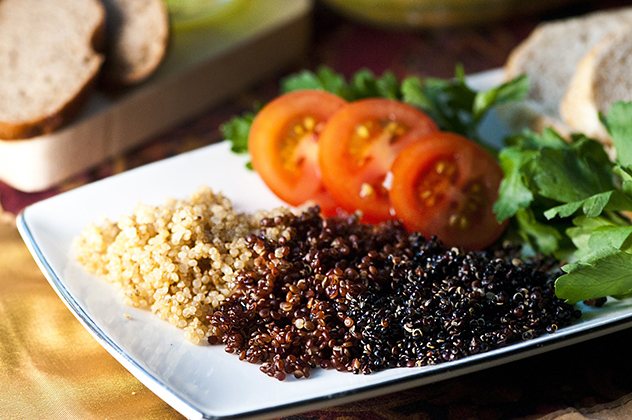
Photo from pixabay.com
Many young mothers make mistakes in their diet. They eat too much or too often. Nutrition should be balanced; dishes for nursing mothers must be carefully selected taking into account the list of permitted and prohibited foods.
Instructions for following the diet by month look something like this:
- 1 month. The most stringent thing on a nursing mother’s menu is the first month, because the baby’s digestive and enzymatic systems are not yet familiar with any nutrients other than sterile amniotic fluid. The main foods in the first months are steamed vegetables, buckwheat or wheat porridge, whole grain bread instead of regular bread, baked apple, low-fat cottage cheese, yogurt, curdled milk, vegetarian soup with herbs, steamed low-fat fish, boiled beef.
- 2-3 month. In the second and third months, the menu can be gradually expanded. The range of porridges is increasing; mommy can now prepare millet, buckwheat or oatmeal porridge for herself. Eggs, pasta, rye bread, some marshmallows and marshmallows are added to the diet. Fats are added to the diet, you can cook food in vegetable oil, and consume 30 grams of butter for breakfast. An occasional handful of almonds is allowed as a delicacy. Fresh vegetables include beets, carrots, zucchini, pumpkin and potatoes.
- 3-6 month. At this stage, lean borscht already appears on the menu of a nursing woman, which is recommended to be cooked with tomato juice or fresh tomatoes. Doctors do not recommend using tomato paste for cooking. Mom can have fresh vegetable and fruit juices, nuts, onions, poultry, homemade jam, honey, but with caution, unless the baby is allergic.
- 6-12 month. The diet becomes more varied, you can sometimes indulge in fried foods. Gradually you can add legumes, seafood, garlic. For dessert, you can treat yourself to a small piece of chocolate. But you should still avoid fatty foods.
From the author. When my son was born, I, of course, tried to eat right, because... colic visited us constantly. Less sweets, no fried, smoked, salads with mayonnaise and so on. I was looking for recipes for nursing mothers in the first months, preparing the simplest ones, looking for answers to the question: “What to cook for a nursing mother that is quick, tasty and healthy.” But the only thing I noticed that I didn’t eat was that it had no effect on the baby’s colic. I ate right - the colic was right there. I went away from a strict diet - colic in the same way. But I didn’t give up on proper nutrition. Because you need to get in shape and, in principle, it’s calmer.
During breastfeeding, there are many prohibitions in the diet of a young mother:
- All products that are conventionally considered allergens are strictly prohibited. This list includes all red fruits, citrus fruits, honey, smoked foods, and chocolate. They are potentially undesirable, but after the baby is six months old, you can carefully try eating them a little and find out how the child reacts to them.
- Products that cause flatulence should be avoided during the first months of breastfeeding. These include white cabbage, cucumbers, melons, radishes, beans, and peas. They can be gradually introduced after three months of age.
- It is better to avoid foods that affect the taste of milk altogether. The baby may stop drinking mother's milk and abandon the breast. These include onions, garlic and asparagus.
- It is recommended to avoid rice as it promotes constipation.
Diet of a nursing mother in the first week after birth
Immediately after childbirth, a woman needs special nutrition. This is due to the fact that now she needs energy to recover after childbirth and properly organize lactation.
During this period, you also need to remember that the baby’s digestive system is very vulnerable and is not capable of digesting the complex food that it receives along with mother’s milk. Therefore, during this period, a woman’s diet should be limited and at the same time contain a maximum of nutrients.
Most women who have just given birth experience a strong feeling of thirst. This is explained by the fact that during the birth process she lost a large amount of fluid, which the body now strives to replenish.
The formation of lactation also requires additional amounts of fluid. During this period, a woman can drink still water, weak tea or a not very sweet compote made from dried fruits.
In the first 7 days from the birth of the baby, mothers should introduce natural fermented milk products without additives (kefir, yogurt, fermented baked milk, etc.) into their diet. But it is better to avoid such products:
- strong tea and coffee, which help stimulate the baby’s nervous system;
- juices are a common cause of food allergies and bloating;
- cereals containing gluten (wheat, millet, pearl barley), as allergies may occur to them;
- fried meat, especially chicken, which may contain antibiotics;
- some vegetables - cabbage, tomatoes, onions;
- whole milk, which is an allergen;
- fermented milk products with additives (store-bought yoghurts, curds);
- fish and other seafood;
- chicken eggs;
- honey and nuts;
- fruits and berries.
In the first week, mother can eat:
- porridge cooked in water (buckwheat, rice, corn);
- pasta;
- steamed vegetables (potatoes, cauliflower, zucchini, carrots);
- boiled rabbit or veal meat;
- low-fat fermented milk products (cottage cheese, kefir, sour cream);
- black bread, crackers;
- vegetable oil;
- biscuits.
Such a limited menu in the first week of a baby’s life is necessary so that he does not have digestive problems and allergies.
Recipes for first courses during gw
Despite many prohibitions, you can prepare wonderful soups that should definitely be present in the diet of a nursing mother. After all, first courses are the path to proper, healthy and varied nutrition.
Recipes for a nursing mother of a newborn include the following soups:
Chicken soup with dumplings

Photo of a recipe for a simple and tasty soup for nursing mothers
- Skinless chicken breast should be boiled.
- Add diced potatoes, grated carrots and a little onion to the broth.
- Prepare the dumplings as follows: mix 1 egg with milk and egg until thick sour cream, add salt.
- Next, use a teaspoon to drop the dough into the boiling broth. It will take 5-7 minutes for them to be ready, so you should throw the dumplings into the soup when the vegetables are not yet cooked.
- Add bay leaf if desired.
- The soup is ready when the dumplings float to the surface and cook for a couple more minutes.
Fish soup

Photo from foodnetwork.com
Cooking the fish soup will take 40 minutes. It will require white fish that does not cause allergies, for example, cod or saury, which must be cleaned of scales and bones.
- Boil the fish and remove from the broth.
- Shredded potatoes, carrots, onions and 1 tablespoon of semolina are added to the boiling soup.
- At the end of cooking, add salt and return the fish pieces to the soup.
Borsch
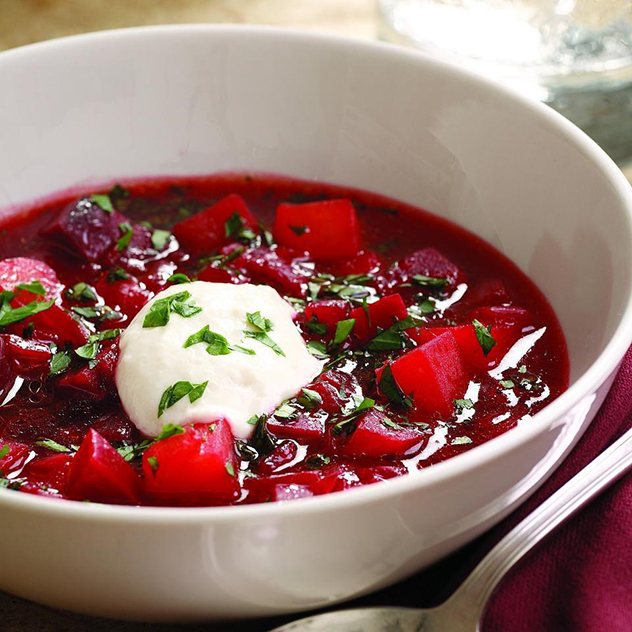
Photo from eatingwell.com
It can be prepared with a piece of lean beef. Instead of white cabbage, use cauliflower.
- Boil the beef; after boiling, the first broth should be drained.
- While the meat is cooking, you need to peel and cut the beets into strips, potatoes into cubes, grate the carrots and chop the onion, divide the cauliflower into inflorescences.
- For a spicy taste, you can add finely chopped zucchini.
- When the beef is ready, add all the vegetables except the zucchini. It should be thrown into the borscht last.
- Add some salt at the end; it’s healthier to use sea salt.
- It is better to simmer vegetables in broth over low heat in order to preserve their beneficial properties as much as possible. You can add a little sour cream to the finished borscht.
Rice soup with meatballs
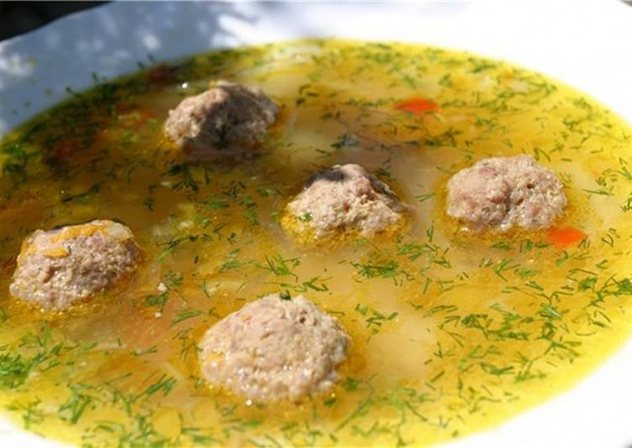
Photo from cookpad.com
The meat should be lean. It could be chicken or turkey.
- While the rice is cooking, prepare the minced meat.
- You need to salt it a little and add chopped onion.
- To make the meatballs tender, you can add a piece of soaked unsweetened bread to them.
- Shape meatballs to the size of a walnut.
- When the rice is half cooked, add the cooked vegetables and meat balls one at a time into the broth.
- At the end, add salt to the soup.
Menu (Power Mode)
The diet, starting from the second month, is more varied, since it already includes beef, chicken, fish and rabbit, and the list of cereals has also been expanded. Vegetables are still stewed or boiled. Below is a sample menu.
Monday
| Breakfast |
|
| Lunch |
|
| Dinner |
|
| Afternoon snack |
|
| Dinner |
|
| For the night |
|
Tuesday
| Breakfast |
|
| Lunch |
|
| Dinner |
|
| Afternoon snack |
|
| Dinner |
|
| For the night |
|
Wednesday
| Breakfast |
|
| Lunch |
|
| Dinner |
|
| Afternoon snack |
|
| Dinner |
|
| For the night |
|
Recipes for main courses while breastfeeding
Since a young mother does not have extra time, recipes for dishes for nursing women should be prepared simply and quickly. Second courses can be as follows:
Baked Potatoes with Cheese

Photo from the site 1000.menu
- Wash the potatoes well without removing the skins.
- Then cut half a centimeter to make an accordion and add salt to taste.
- The cuts should be filled with onions and pieces of butter.
- 5 minutes before ready, sprinkle with grated cheese.
Stuffed pepper

Photo from bettycrocker.com
You will need minced beef or chicken.
- Boil the rice until half cooked and mix with the meat, adding the onion and salting it.
- Remove the insides of the pepper and fill with the prepared mixture.
- Place the peppers in a saucepan, sprinkle with carrots and onions, and add water.
- Simmer until done.
Cutlets with buckwheat
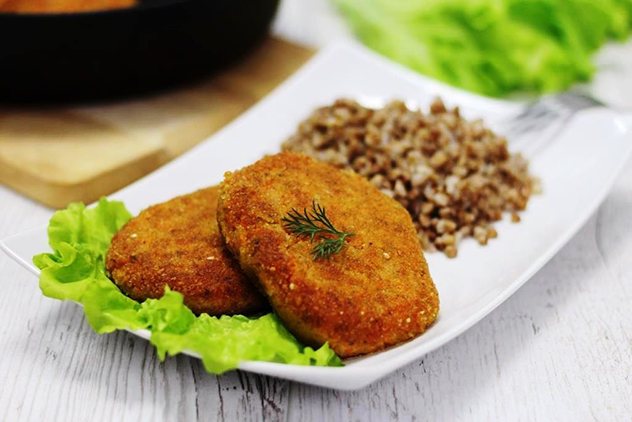
Photo from the site proviantmaster.ru
For minced meat, you can use several types of lean meat to make the cutlets tender.
- They should be cooked in a frying pan to which water is added for steaming.
- It is ideal to simmer them in a double boiler.
- A few minutes before it’s ready, you can put a zucchini ring on the cutlet and an olive, sprinkling everything with grated cheese.
- Separately cook buckwheat porridge.
Fish with mashed potatoes
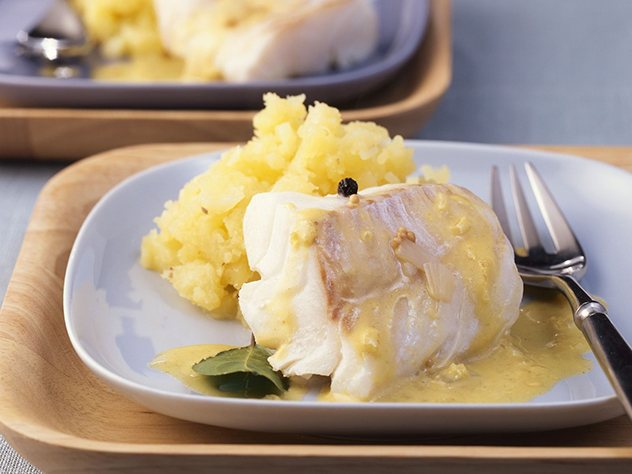
Photo from eatsmarter.com
- Hake or pollock are suitable, which need to be baked in the oven, after adding a little water to the pan.
- After the fish has simmered for 10 minutes, add a few spoons of sour cream and cook until done.
- This fish should be served with mashed potatoes.
Salad Recipes
There are many vegetable recipes, but not everything can be afforded by a young mother feeding a child. Recipes for breastfeeding should not have many components. Salads with fresh vegetables and fruits can be eaten only when the baby’s colic period ends.
Dishes that can be offered to a nursing mother may be as follows:
Caesar salad"

Photo from jessicagavin.com
- For 400 grams of boiled chicken breast you will need three slices of gray bread, 300 grams of lettuce, 100-150 grams of cheese, a pinch of sesame seeds and vegetable oil.
- Cut the boiled meat into cubes, add lettuce leaves torn into pieces, and top with pieces of dried bread, grated cheese and sesame seeds.
- Season with oil, preferably olive oil.
Greek salad
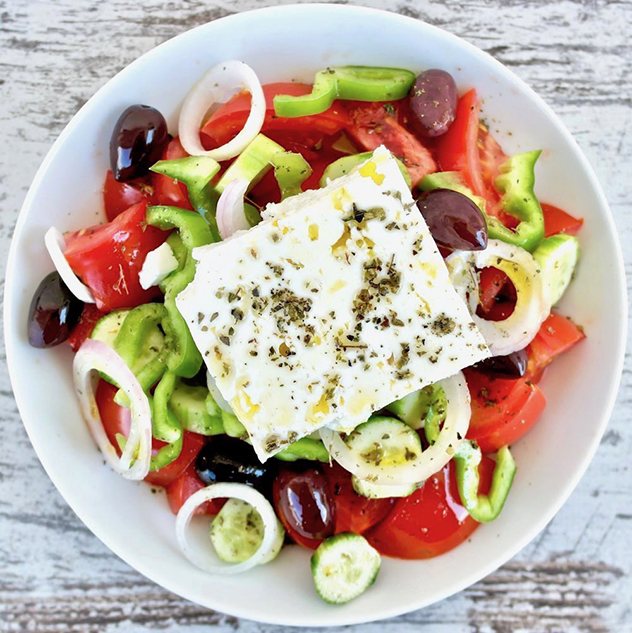
Photo from olivetomato.com
A simple and quick salad to prepare will be very useful for nursing mothers.
- For 300 grams of feta you need to take 2 peppers, 2 cucumbers, several cherry tomatoes, a head of sweet red onion and several olives.
- Chop everything and season with olive oil and lemon juice.
Beetroot salad with nuts
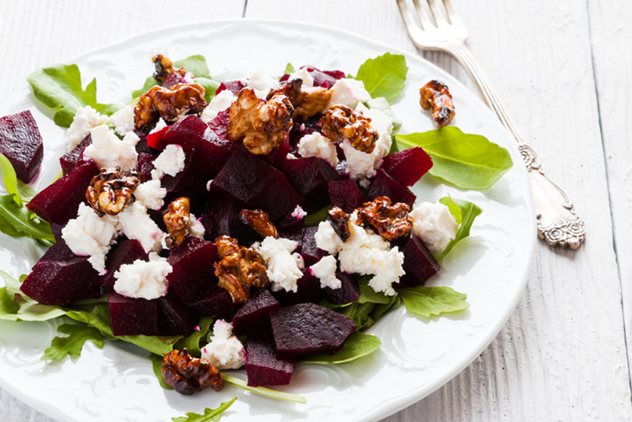
Photo from the site edinstvennaya.ua
A very hearty salad that will help cope with constipation in a young mother.
- Walnuts are suitable for it, of which you will need 1 tablespoon for 2 medium fruits.
- For piquancy, add a small head of red onion and season with flaxseed oil and lemon juice.
Meat salad with apples

Photo from the site volshebnaya-eda.ru
This dish is suitable for every day, it is easy to prepare and contains vitamins.
- For 200 grams of meat you need to take 2 green apples and a bunch of lettuce leaves.
- Season with olive oil and lemon juice.
A nursing mother's diet must include fresh vegetables.
Dessert Recipes
Store-bought baked goods should be excluded from the diet because they contain harmful additives. You can offer the following sweet recipes while breastfeeding:
Dumplings with pumpkin and raisins

Photo from gastronom.ru
- Prepare the dough from 1.5 cups of milk, 1 egg, 1 tbsp. l. vegetable oil, flour and salt.
- For the filling you will need pumpkin, sugar, raisins and a piece of butter.
- The dough must be kneaded until it becomes a homogeneous elastic mass.
- Grate the pumpkin and simmer with the ingredients for the filling.
- Boil the dumplings in salted water for about 3 minutes after floating.
Following the step-by-step recipe, it is not at all difficult to prepare such a delicious dish, even if you had no cooking skills before.
Pancakes
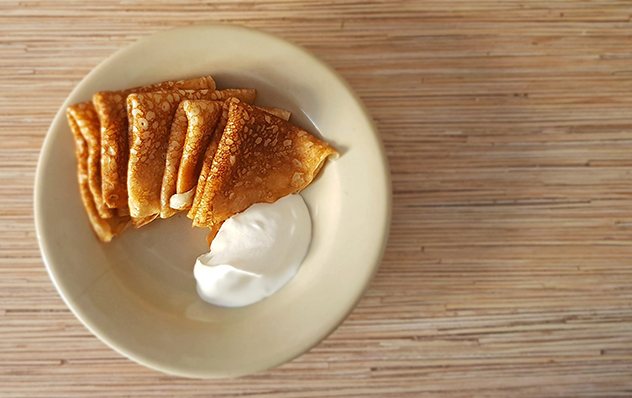
Photo from pixabay.com
- Dilute 4 tbsp in a glass of water. l. flour, add salt, soda, sugar, 3 tbsp. l. vegetable oil.
- Beat everything well and fry in a frying pan.
Cottage cheese and apple casserole

Photo from gastronom.ru
This delicate dessert is perfect for a nursing mother.
- Add an egg, sugar, a spoonful of sour cream and a little semolina to the cottage cheese.
- Bake until done in an oven preheated to 180 degrees.
This recipe can be wonderfully prepared in a slow cooker.
In order for a woman to eat quality food, and at the same time the baby does not suffer from stomach problems, it is necessary to use recipes for nursing mothers, gradually adding new products. At one year, you can switch to a regular diet, wean your baby from the breast and feed according to the children's menu.
Drinking regimen of a nursing mother
During childbirth, the female body becomes dehydrated, losing a lot of fluid. Therefore, he urgently needs to replenish it.
In addition, the quantity and quality of breast milk will depend on how much of it enters the mother’s body. It was experimentally found that 1 glass of water, drunk 15-20 minutes before feeding, promotes the production of milk in greater quantities.
The daily fluid intake for a woman during breastfeeding is 2-2.5 liters. This also includes soups, juices, milk and other liquids.
It is worth considering that everything that was drunk and eaten by the mother directly affects the quality of breast milk. Therefore, it is better to give preference to mineral or purified water without gas as a drink.
